
Jasmine is a genus of shrubs and vines in the olive family of Oleaceae. It contains around 200 species native to tropical and warm temperate regions of Eurasia, Africa, and Oceania. Jasmines are widely cultivated for the characteristic fragrance of their flowers. A number of unrelated plants contain the word "jasmine" in their common names.

The Cyperaceae are a family of graminoid (grass-like), monocotyledonous flowering plants known as sedges. The family is large, with some 5,500 known species described in about 90 genera, the largest being the "true sedges" genus Carex with over 2,000 species.

William Aiton was a Scottish botanist.

Nasturtium is a genus of a small number of plant species in the family Brassicaceae commonly known as watercress or yellowcress. The best known species are the edible Nasturtium officinale and Nasturtium microphyllum. Nasturtium was previously synonymised with Rorippa, but molecular evidence supports its maintenance as a distinct genus more closely related to Cardamine than to Rorippasensu stricto.
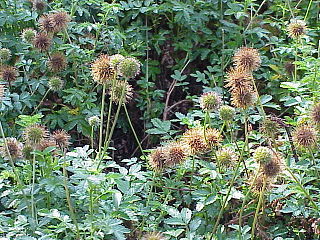
Acaena is a genus of about 60 species of mainly evergreen, creeping herbaceous perennial plants and subshrubs in the family Rosaceae, native mainly to the Southern Hemisphere, notably New Zealand, Australia and South America, but with a few species extending into the Northern Hemisphere, north to Hawaii and California.
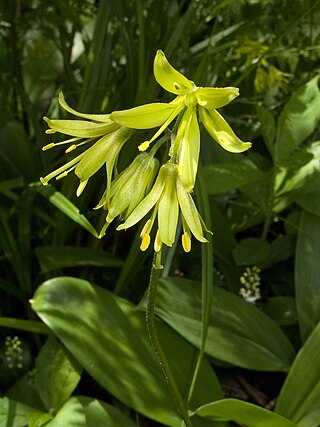
Clintonia borealis is a species of flowering plant in the lily family Liliaceae. The specific epithet borealis means "of the north," which alludes to the fact that the species tends to thrive in the boreal forests of eastern Canada and northeastern United States.
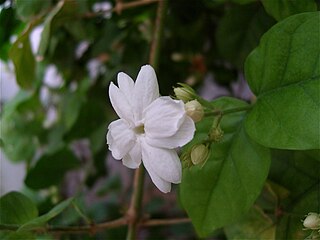
Jasminum sambac is a species of jasmine native to tropical Asia, from the Indian subcontinent to Southeast Asia. It is cultivated in many places, especially West Asia, South Asia and Southeast Asia. It is naturalised in many scattered locales: Mauritius, Madagascar, the Maldives, Christmas Island, Chiapas, Central America, southern Florida, the Bahamas, Cuba, Hispaniola, Jamaica, Puerto Rico, and the Lesser Antilles.
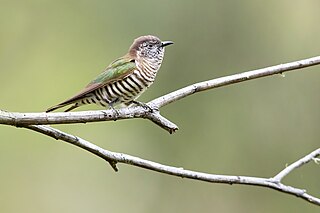
The shining bronze cuckoo is a species of cuckoo in the family Cuculidae, found in Australia, Indonesia, New Caledonia, New Zealand, Papua New Guinea, Solomon Islands, and Vanuatu. It was previously also known as Chalcites lucidus.

Puccinellia is a genus of plants in the grass family, known as alkali grass or salt grass.

Symphyotrichum lateriflorum is a species of flowering plant in the aster family (Asteraceae). Commonly known as calico aster, starved aster, and white woodland aster, it is native to eastern and central North America. It is a perennial and herbaceous plant that may reach heights up to 120 centimeters and widths up to 30 centimeters.
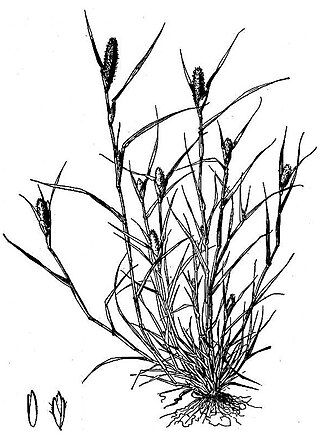
Crypsis is a genus of African and Eurasian plants in the grass family, sometimes referred to as pricklegrass. These are annual grasses with short leaves. A few species are invasive weeds outside their native ranges.
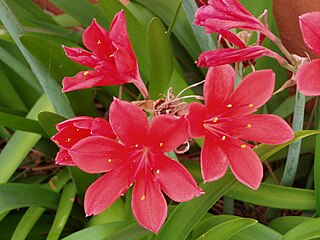
Cyrtanthus is a genus of perennial, herbaceous and bulbous plants in the family Amaryllidaceae, subfamily Amaryllidoideae.

Acaena magellanica, commonly called buzzy burr or greater burnet, is a species of flowering plant whose range includes the southern tip of South America and many subantarctic islands.

The Paradisus Londonensis is a book dated 1805–1808, printed by D.N. Shury, and published by William Hooker. It consists of coloured illustrations of 117 plants drawn by William Hooker, with explanatory text by Richard Anthony Salisbury.
Pseudoxandra lucida is a species of plant in the family Annonaceae. It is native to Bolivia, Brazil, Colombia, Peru, and Venezuela. Robert Elias Fries, the Swedish botanist who first formally described the species, named it after its shiny leaves.

Symphyotrichum patens, commonly known as late purple aster or spreading aster, is a perennial, herbaceous plant found in the eastern United States.

Acaena microphylla, the bidibid or piripiri, and outside New Zealand, New Zealand-bur, is a small herbaceous, prostrate perennial flowering plant in the rose family Rosaceae, native to both the North and South Islands of New Zealand. There are two varieties:
Teedia is a genus of flowering plants belonging to the family Scrophulariaceae.
Oligomeris is a genus of flowering plants belonging to the family Resedaceae.
















